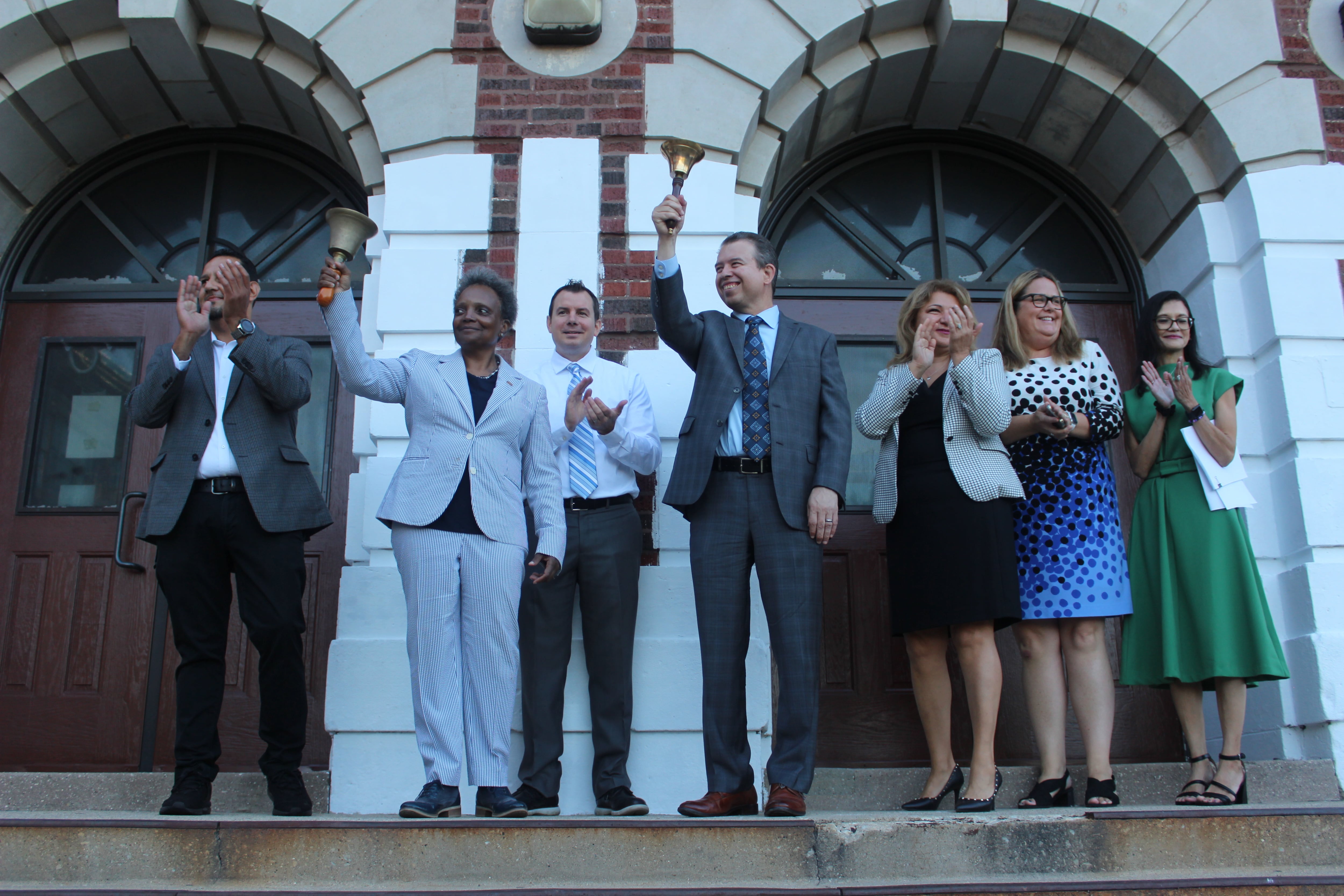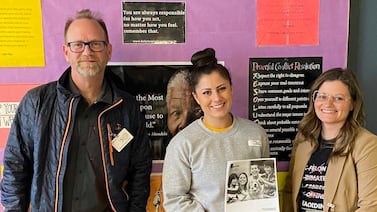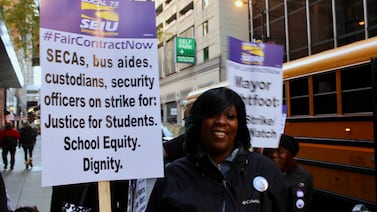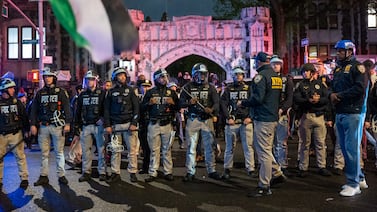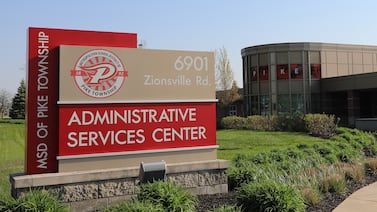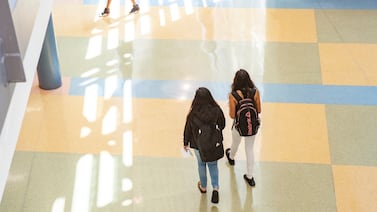Outside Falconer Elementary school on Chicago’s Northwest side shortly after 7:30 a.m., fourth grader Sebastian Benitez beamed with pride as he shook hands with Mayor Lori Lightfoot.
Surrounded by his mom and younger siblings, the politics lover dressed in a blue polo and sweater said he hoped to get straight As, after bringing home one B last year.
“I’m going to try to boost that up,” he said. “I’m going to try to do better.”
Like Benitez, Lightfoot and her hand-picked schools CEO Pedro Martinez are hoping for a better year, after two tumultuous ones navigating the pandemic’s massive disruption to learning.
“I expect this to be one of the CPS strongest years ever,” Martinez said during a mid-morning press conference at Excel Academy of South Shore, an alternative school on the South Side.
The district is pledging to redouble efforts to have the recovery year officials hoped for last year, before COVID surges, staffing challenges, and other issues emerged.
Martinez will soon outline a three-year blueprint for the district that aims to strengthen neighborhood schools, career and technical education, services for students with disabilities, and more.
Despite notable challenges, Martinez said he and his team were working to ensure student safety, up-to-date COVID-19 protocols, and providing students with high quality teachers and staff.
Staffing challenges still linger
According to publicly available data, there are roughly 3,000 additional positions district wide compared to pre-pandemic and more dollars for professional development.
However, not all additional positions are filled. As of Monday, Martinez said the district had 900 vacant teacher positions districtwide, an uptick from last year when it had 600.
“We’re in a much better place than last year,” Martinez said, while acknowledging that hiring is ongoing. “We’re still hiring bus drivers. We’re still hiring custodial staff. We’re still hiring crossing guards.”
The district is planning to deploy long-term substitutes, Martinez added.
The tenor of the first day of classes also signaled a more cordial tone between district leadership and the teachers union.
Outside Back of the Yards College Preparatory High School, Chicago Teachers Union leaders and members suggested a new era of more cooperation with the district is within reach.
“There’s a great opportunity for setting a fresh start,” said Rebecca Martinez, the union’s director of organizing. “I think that’s what’s wonderful about the beginning of a school year.”
Others spoke about the difficulties of filling some vacant positions, particularly for educators and support staff who work with students with disabilities and English language learners.
Maggie Slavin, a teacher starting her second year at Back of the Yards, said the high school is entering the new school year fully staffed with special education educators and paraprofessionals. But she worries that’s not the case at all CPS schools. She urged district officials to streamline and speed up the process for hiring and onboarding new staff.
Music teacher Felix Ponce called on the district to deliver on promises to invest in more equitable access to arts education — an issue he said the district and union leaders should tackle together.
Recent Back of the Yards graduate Britney Quiroz, now a student at New York University, urged leaders to stay tuned in to what students are telling them they need — and encouraged fellow students to get involved.
“Student voice is crucial to the growth of our community,” said Quiroz. “The youth are gifted with the ability to reimagine.”
Some students face bus rides longer than an hour
Over the summer, district officials took steps to avoid busing issues that last year left students waiting for rides that sometimes never came. Martinez admitted Monday that hundreds of students are still facing bus rides that are more than an hour each way.
Union president Stacy Davis Gates alluded to those challenges during a speech at the City Club, noting that some children with disabilities will need to ride the school bus “for hours,” she said.
Despite a national shortage of bus drivers, the district has managed to route over 15,600 students across CPS. It continues to work to hire more drivers by increasing hourly wages, offering alternative modes of transportations such as taxis, and monthly stipends for parents.
Families who made transportation requests after July will need to wait a few weeks. About 80% of routes were under an hour, but Martinez noted that he was looking at a percentage of routes that are longer and would be looking at opportunities for improvements to those longer commutes.
“I ask families to be patient with us,” Martinez said. “Give us a couple of weeks. There’s going to be opportunities for us to get more efficient on the routes.”
Safety concerns heightened after mass shootings, city violence
Davis Gates offered a starkly different take on the state of Chicago Public Schools than Martinez in his own City Club address last week, when the CPS chief said the pandemic had disrupted but not broken a district on the rise — with record graduation rates and rapid academic growth.
Davis Gates said a decade of school closures and experiments in education reform and school turnarounds had failed students.
“We should all be disappointed in ourselves,” she said. “That’s an F.”
Offering up an alternative to Martinez’s yet-to-be-released blueprint, Davis Gates said the union would advocate for beefing up arts and athletic programs, and expanding the sustainable community schools model, in which campuses partner with community organizations to offer students added support.
Martinez and Lightfoot touted the steps the district plans to take this year to support students’ mental health and get them re-engaged in school.
While the festive mood filled schools, some parents said school safety weighed heavily in their minds following the mass shootings in Uvalde, Texas and Highland Park earlier this year.
Jonathan Martinez and Natasha Alcedo, parents of a fifth grade Falconer student, were nervous about the “unfortunate” shootings, but hopeful for a safe and blessed school year.
“As parents, we always get nervous when children go back to school,” Alcedo said. “We hope that they’re learning well and that the teacher and kids are nice to them — along with any other safety precautions that we’re always worried about on a day to day basis.”
Jadine Chou, CPS’ chief of safety and security, said the district and multiple city agencies, including the Chicago Police Department and the city’s Office of Emergency Management, conducted a drill last week in preparation, Chou said. The district conducts over 3,800 drills every year, she noted.
The district has also implemented a new visitor management system, new safety video training, and expanding programs that go beyond physical safety to offer social, emotional, and mental health support, Chou said.
“We take safety and security in CPS very seriously,” Lightfoot said.
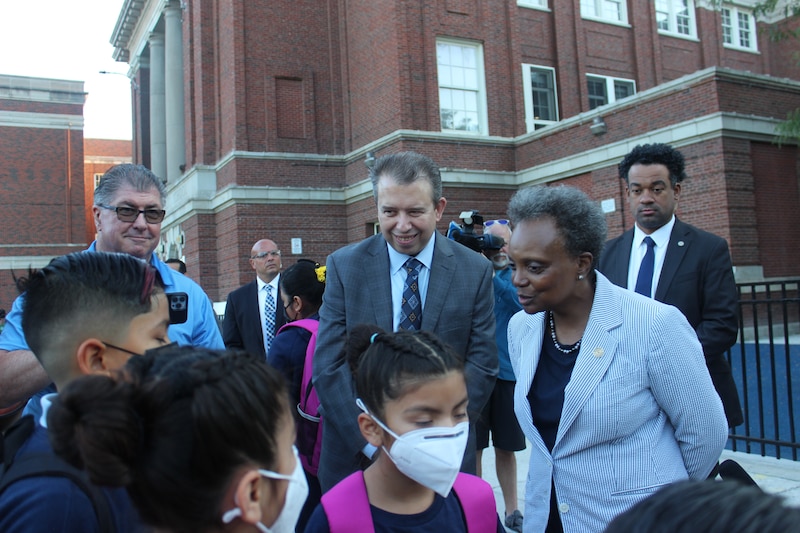
As Lightfoot and Martinez greeted families at Falconer, they peppered students with questions about their first-day hopes and offered compliments on haircuts and lunch boxes.
Hundreds of students and parents awaited the opening bell — a signal of the official end of summer for students — including Ethan Duran, his mother, and two siblings. The third grader has been eager to return to the classroom, in part, to play on the newly installed playground.
His mother, Soledad Galvan, was cautious about the return to school. She said unknown questions around the monkeypox virus and making sure schools were secure “no matter what” were top of mind for her.
Despite those concerns, she is hopeful for a good year for her three children.
So is her son, who eyed the playground and said: “I’m excited!”
Mauricio Peña is a reporter for Chalkbeat Chicago, covering K-12 schools. Contact Mauricio at mpena@chalkbeat.org.
Mila Koumpilova is Chalkbeat Chicago’s senior reporter covering Chicago Public Schools. Contact Mila at mkoumpilova@chalkbeat.org.


